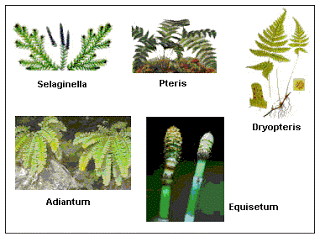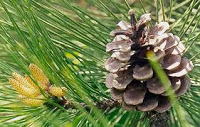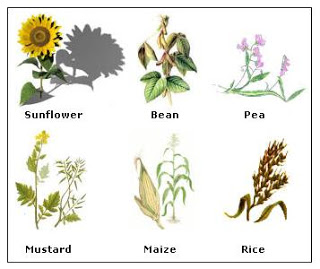Biology
4 Plant Divisions:

Bryophytes are the most common plant division and are made up mosses, liverworts and hornworts. They are found in almost every habitat, including deserts but are most adaptable to moist environments. This is thought to be the first plant division dominate the environment. Two characteristics that distinguish them are that they lack specialized vascular tissue (xylem and phloem), and they are nutritionally dependent on the gametophyte. Pteridophytes are vascular plants such as ferns, horsetails, and lycophytes. This division reproduce using spores instead of seeds, which is why they are often referred to as 'seedless plants'. Two features that make them stand out are their large pinnate leaves and their ability of circinate vernation; meaning the young ferns have a protective spiral coiling.
Pteridophytes are vascular plants such as ferns, horsetails, and lycophytes. This division reproduce using spores instead of seeds, which is why they are often referred to as 'seedless plants'. Two features that make them stand out are their large pinnate leaves and their ability of circinate vernation; meaning the young ferns have a protective spiral coiling. Gymnosperms are plants that have 'naked' seeds, meaning they are not enclosed in fruit or pods. They include conifers, ginkgo, cycads, and gnetae. Features of this division are plants containing cones or strobili, with visible seeds.
Gymnosperms are plants that have 'naked' seeds, meaning they are not enclosed in fruit or pods. They include conifers, ginkgo, cycads, and gnetae. Features of this division are plants containing cones or strobili, with visible seeds.
Angiosperms are plants that have seeds enclosed in something such as a fruit. They also reproduce and bear flowers, this means that the division includes all flowering plants; roses, sunflowers, fruit trees, etc. It is the most diverse and large group of plants because they can be anything from shrubs to trees.
- Phloem & Xylem
Are Phloem and Xylem Similar? What are the Differences? Similarities: Phloem and xylem are tissues in a plant that transport food and water. Both are vascular tissues and when they work together to effectively transport food, water and minerals they form...
- C4 Plant
The corn plant is an example of a C4 Plant. In plants, the first step of the Calvin Cycle is carbon fixation. When most plants undergo carbon fixation they form a 3 carbon compound. However, C4 plants form a 4 carbon compound. C4 plants are found in hot...
- #38.1 Transport In Multicellular Plants - Syllabus 2015
? The need for, and functioning of, a transport system in multicellular plants Learning Outcomes Candidates should be able to: (a) explain the need for transport systems in multicellular plants and animals in terms of size and surface area to...
- Population: Ecology
This picture was taken at the Arnold Arboretum. Here is a large plot of land where many different shrubs and trees grow for display. All of these plants in one area are their own population. A population consists of organisms that can successfully reproduce...
- 4/10/14
We have aqueduct on friday over plants and I hope I get a good grade so I can bring my grade up from a 91. Then we checked on our germination and box plants. My box plant has grown but my germination seeds roots are longer. Then we dissected a flower...
Biology
Plant Divisions
4 Plant Divisions:

Bryophytes are the most common plant division and are made up mosses, liverworts and hornworts. They are found in almost every habitat, including deserts but are most adaptable to moist environments. This is thought to be the first plant division dominate the environment. Two characteristics that distinguish them are that they lack specialized vascular tissue (xylem and phloem), and they are nutritionally dependent on the gametophyte.
 Pteridophytes are vascular plants such as ferns, horsetails, and lycophytes. This division reproduce using spores instead of seeds, which is why they are often referred to as 'seedless plants'. Two features that make them stand out are their large pinnate leaves and their ability of circinate vernation; meaning the young ferns have a protective spiral coiling.
Pteridophytes are vascular plants such as ferns, horsetails, and lycophytes. This division reproduce using spores instead of seeds, which is why they are often referred to as 'seedless plants'. Two features that make them stand out are their large pinnate leaves and their ability of circinate vernation; meaning the young ferns have a protective spiral coiling. Gymnosperms are plants that have 'naked' seeds, meaning they are not enclosed in fruit or pods. They include conifers, ginkgo, cycads, and gnetae. Features of this division are plants containing cones or strobili, with visible seeds.
Gymnosperms are plants that have 'naked' seeds, meaning they are not enclosed in fruit or pods. They include conifers, ginkgo, cycads, and gnetae. Features of this division are plants containing cones or strobili, with visible seeds.
- Phloem & Xylem
Are Phloem and Xylem Similar? What are the Differences? Similarities: Phloem and xylem are tissues in a plant that transport food and water. Both are vascular tissues and when they work together to effectively transport food, water and minerals they form...
- C4 Plant
The corn plant is an example of a C4 Plant. In plants, the first step of the Calvin Cycle is carbon fixation. When most plants undergo carbon fixation they form a 3 carbon compound. However, C4 plants form a 4 carbon compound. C4 plants are found in hot...
- #38.1 Transport In Multicellular Plants - Syllabus 2015
? The need for, and functioning of, a transport system in multicellular plants Learning Outcomes Candidates should be able to: (a) explain the need for transport systems in multicellular plants and animals in terms of size and surface area to...
- Population: Ecology
This picture was taken at the Arnold Arboretum. Here is a large plot of land where many different shrubs and trees grow for display. All of these plants in one area are their own population. A population consists of organisms that can successfully reproduce...
- 4/10/14
We have aqueduct on friday over plants and I hope I get a good grade so I can bring my grade up from a 91. Then we checked on our germination and box plants. My box plant has grown but my germination seeds roots are longer. Then we dissected a flower...
